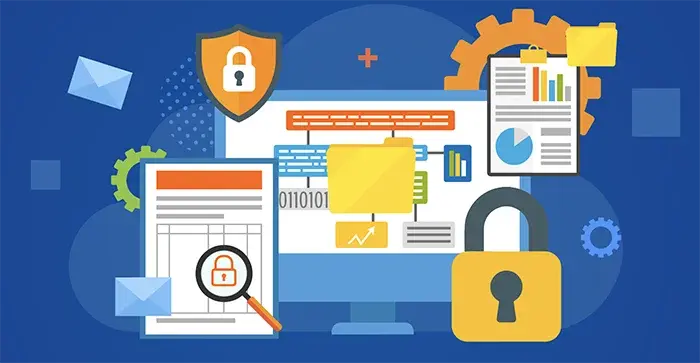Digital Rights Management(DRM), Meet Digital Asset Management (DAM)

Digital rights management (DRM) is how organizations control access to copyrighted digital assets. This can include assets around a brand's identity, or it can also relate to tracking the rights of licensed digital files or marketing materials. Digital rights management ensures that assets related to a spokesperson, musician, or company branding are used correctly.
For those that don't know how DRM works, let's provide an example. Let’s say you have an image in your digital asset management (DAM) system. That one image can have multiple digital rights (DR) issues at play. For example:
- The image is part of a top-secret campaign that can only be seen by a few team members prior to its release date.
- It features three different models, each of whom have specific model releases.
- The image uses an anniversary-themed variant of your logo that can only be used for one year.
- The image is approved for use in North America, but not in other regions.
If your DAM platform has DRM features, you can organize your assets and protect them at the same time to increase productivity and maintain brand consistency.
Schedule a Call!
Why is DRM important?
There are many reasons to protect your digital rights, such as protecting your brand guidelines, and ensuring you're adhearing to the rights around particular file types.
Brand security
Making sure your brand assets are consistent and on-brand is important, even if that brand changes over time. DRM can help ensure your content is consistent across channels. It can also prevent users from distributing assets that haven’t been approved yet.
Liability
Using the wrong asset at the wrong time can open a business up to a host of legal woes. Asset managers can have many things to think about, like model and music release forms, colors, logos, and more. For example, one telecom company was sued just for using the wrong font on a landing page.
Compliance
Be aware if your organization requires your DAM software to fillow various compliance standards, such as HIPAA for hospitals, or organizations in EU being required to choose DAM platforms that are GDPR compliant.
Schedule a Call!
How does digital rights management work in a DAM?
Some digital asset management systems have prioritized rights management features, offering tools that can help track the rights and usage of your various digital assets. Here are a few examples of how DAM can help you manage asset rights:
Permissions
Setting which departments, groups or individuals can see an asset is only the beginning. An enterprise DAM platform can offer a host of granular controls that let you manage who can access assets. Make sure your permissions let you control:
- Format: Some permissioning systems allow you to set the resolution or format for an asset. For instance, you could only allow general users to see lower-resolution proxies rather than giving them access to the original format, or require they only download watermarked images.
- Download: Don’t want an asset to ever make it into the public eye? Set permissions to stop users from downloading.
- Share: If you have sensitive assets, you can keep them safe by limiting who can share digital assets.
- Visibility: A change to visibility class or status can quickly move assets into — or out of — the public eye. For instance, you could prevent assets from being shared if they don’t have an “Approved” visibility.
Embargo / Expiration Dates
Rights management often amounts to time management. Knowing when an asset can be safely used is half the battle in shielding a company from liability. DAM software can help by letting you set — and forget — dates for releasing or removing assets from view. The digital asset management system can do the work by changing access automatically when dates arrive.
Some DAM systems even have features that let you send notifications to users when an asset is about to expire, so they can stop using it.
Restrictions
Restrictions are the mirror of permissions, preventing access rather than granting it. One example would be a DAM letting you add a search restriction to hide assets from unauthorized users’ searches. Some even let you add geographic restrictions, so an asset can only be viewed in certain regions or territories.
Watermarks
Watermarking is a simple, effective way to reduce pirating of your digital media. Many digital asset management systems offer multiple methods for adding a watermark to assets on download or when shared. Watermarks can range from small logos identifying your company to large, aggressive watermarks designed to make pirating assets extremely difficult. For example, videos could feature a moving watermark or documents could have a broad “Confidential” watermark prominently on the page.
Compliance
Some rights management is related to complying with regulatory requirements, like HIPAA or FINRA. For instance, if you have personally identifiable information in the DAM, your DAM should offer specific features that let you keep those assets safe.
Schedule a Call!
Automatic updates
Worried about sites featuring old assets? If you embed content directly from the DAM, then you can update assets everywhere at once when a new version is released.
Terms of Service
A DAM solution can let you cover yourself legally by adding Terms of Service to assets. You can have users check that they’ve reviewed Terms of Service or even include Terms of Service as a required part of downloads.
External usage
It’s 10 p.m. — do you know where your assets are? Integrations with A.I. services (like Google Cloud) can show you where your assets can be found outside the DAM, letting you pursue assets that are appearing where they shouldn’t.
Lockdown
Picture this: The spokesperson for your latest campaign has just said something … regrettable on social media. Need to make sure no one touches the assets featuring him for a little while? Search for assets that he’s tagged in and use a lockdown feature to prevent users from finding or sharing them.
Embedded Metadata
Embedding metadata is a little like tattooing important information onto the asset. This makes it easier to analyze assets when they aren’t in the DAM — and makes it easier to identify assets that show up where they don’t belong.
Adding DRM to your DAM
Digital rights and digital asset management are a natural pairing. Both DRM and DAM are designed to keep your assets secure. And with the right digital asset management solution, you can handle both from the same system.
To learn more about Orange Logic's DRM tools, book a call today!
Get the enterprise DAM you'll never outgrow. Meet with Orange Logic today!
OrangeDAM is an Enterprise Digital Management Platform built to grow with your business.
- 130+ custom tools
- Tailored dashboards for every user
- Unlimited scalability


%20(1).webp?width=60&height=60&name=OL%20Short%20Logo%20(2)%20(1).webp)